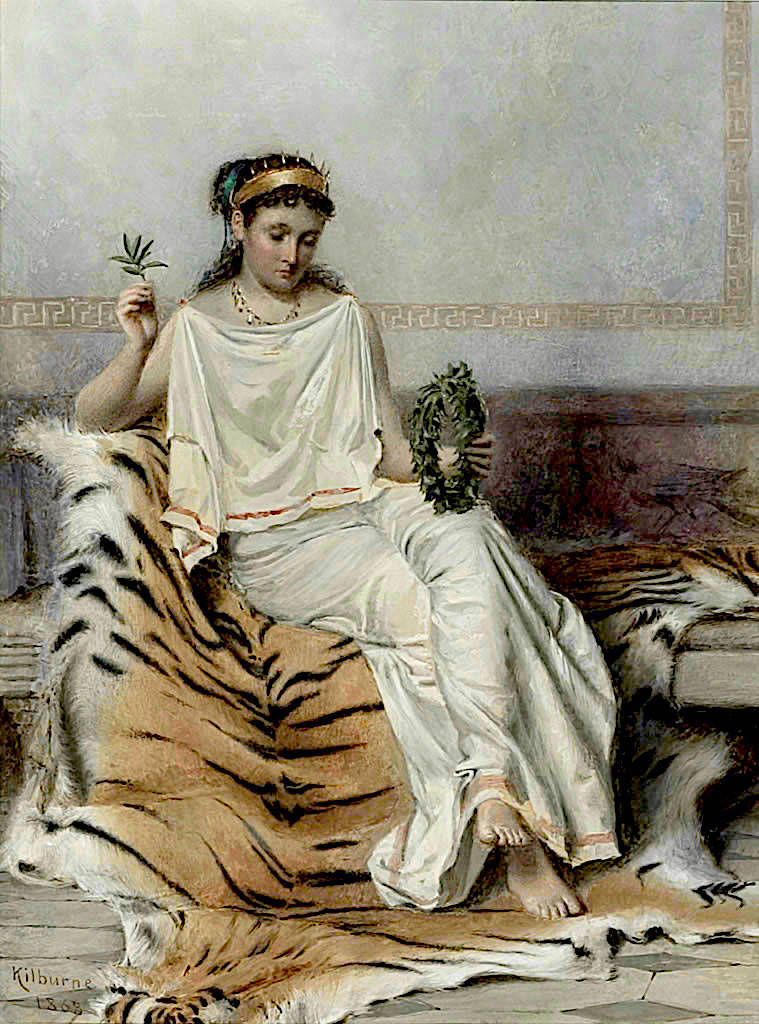

Left: The Victor’s Wreath by Alfred Hassam. 1868. Watercolour and gouache on paper, 101/8 x 7 inches (25.7 x 17.8 cm). Signed and dated “A Hassam 2/68,” lower left. Private collection. Right: The Victor’s Wreath by George Goodwin Kilburne, 1868. Watercolour and gouache on paper, dimensions unknown. Signed and dated “Kilburne 1868,” lower left. Private collection. [Click on images to enlarge them.]

he existence of these two closely related works by two different artists is a most unusual occurrence. The watercolour by Hassam is remarkable in being one of earliest works of Aesthetic Classicism to be exhibited in England. At this time only major Aesthetic Movement artists like Frederic Leighton, Albert Moore, James McNeill Whistler, Simeon Solomon, and G. F. Watts were exhibiting such paintings. Edward Poynter was still largely exhibiting Egyptian subjects while Lawrence Alma-Tadema had yet to move to London, although he was already exhibiting at Ernest Gambart’s The French Gallery from 1865. This watercolour is therefore just one more example of how Hassam was in the vanguard of the progressive art of the 1860s. Although it was exhibited at Society of British Artists in 1868, cat. no. 1009, the major influence on this watercolour was probably the works Simeon Solomon was then showing at the Dudley Gallery. Solomon frequently has figures in his compositions holding olive leaves in their hands, as does the woman in this watercolour by Hassam. An olive wreath, known as a kotinos, was awarded as a symbol of peace and honour to the winners of events at the ancient Olympic games held at Olympia in Greece. In this painting the young woman, quite obviously from the upper classes judging from her attire and surroundings, has weaved a victory wreath for the man she loves. Hassam’s work was also obviously influenced by ancient Roman wall paintings, such as those found at Pompeii, because the surface texture he achieves with the use of gouache is reminiscent of that seen on these ancient frescoes. Such a fresco can be seen in the background.
What is even more surprising, however, is that George Goodwin Kilburne did a virtually identical watercolour on this theme in the same year 1868. This is a very atypical subject in Kilburne’s oeuvre because he is almost exclusively known for his domestic genre paintings of figures in eighteenth- and early nineteenth-century century, generally featuring attractive young women. Both these watercolours of The Victor’s Wreath show a solitary classically draped female figure whose costumes and accessories, including the gold coronets on their heads, are virtually identical. The two figures are in almost exactly the same pose, except for a slight variation in the position and tilt of their heads. Both have a sprig of olive leaves in their right hands and are holding an olive wreath in their left hands. Both are sitting on tiger skins, although Hassam’s figure is on a chair while Kilburne’s is on a bench. There are also some similarities in the background wall decorations, although these are more elaborate in Hassam’s picture.
This is highly unlikely to be a blatant case of one artist plagiarizing the other’s work and is more likely to be the result of the two artists sharing the same model simultaneously. From the appearance of the finished watercolours it suggests that Kilburne was looking at the model straight on while Hassam was slightly to his left. Certainly the pose of the model in both watercolours suggests the two artists were seated right next to each other. The two works are not completely identical and the artists changed some aspects in their finished watercolours, such as what the model was sitting on and the backgrounds. The existence of these two watercolours raises some interesting questions.
Were these two artists friends and could they possibly even have shared a studio together? They were both young and close in age in 1868 – Kilburne was twenty-nine and Hassam twenty-six. Kilburne was the more established artist having been elected a member of the New Water Colour Society in 1866. Kilburne is also known to have been a member of the Artist Society Club at Langham (Langham Chamber Society) and the associated Langham Sketching Club. Whether Hassam was a member is unknown, but because so many young progressive artists were it is certainly a possibly. At the Artist Society Club there was opportunities to make studies from life, both from draped and nude models. Members were given a subject that had been decided upon the previous evening to make sketches of within a limited time period. Models were certainly known to have posed in classical costumes and were expected to hold this pose, often in an uncomfortable position, for a couple of hours. The sketches made at this time would obviously not have been of the quality to be considered “exhibition pieces,” but artists could later work up their initial idea into a finished work of art in their studios if they so chose. The question is whether this is what might have happened in the case of these two watercolours. It is more likely, however, considering the finished nature of these two watercolours, that Hassam and Kilburne may have shared a studio and hired a model that they jointly used to achieve their finished works. While Hassam showed his watercolour at the Society of British Artists it has not been determined whether Kilburne exhibited his version.
Last modified 18 May 2014